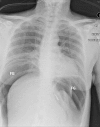Abdominal compartment syndrome caused by tension pneumoperitoneum in a scuba diver
- PMID: 23131212
- PMCID: PMC3954312
- DOI: 10.1308/003588412X13373405385773
Abdominal compartment syndrome caused by tension pneumoperitoneum in a scuba diver
Abstract
Abdominal compartment syndrome is a surgical emergency caused by a raised intra-abdominal pressure, which may lead to respiratory, cardiovascular and renal compromise. It is most commonly seen in post-operative and trauma patients and it has a variety of causes. Tension pneumoperitoneum (TP) is a rare cause of abdominal compartment syndrome most often seen after gastrointestinal endoscopy with perforation. We present the case of a fit 52-year-old experienced female diver who developed TP and shock following a routine training dive to 27m. Following accidental inhalation of water, she had an unstaged ascent and, on reaching the surface, developed severe acute abdominal pain and distension. She was brought to our emergency department by air ambulance for assessment. Clinical and radiological examination revealed a shocked patient with dramatic free intra-abdominal gas and signs of abdominal compartment syndrome, which was treated with needle decompression. Symptoms and signs resolved quickly with no need for further surgical intervention. TP is a surgical emergency where surgery can be avoided with prompt diagnosis and treatment.
Figures
Similar articles
-
Tension pneumoperitoneum: a very rare complication of acute gangrenous appendicitis.Ann R Coll Surg Engl. 2016 Nov;98(8):e197-e199. doi: 10.1308/rcsann.2016.0240. Epub 2016 Sep 22. Ann R Coll Surg Engl. 2016. PMID: 27652797 Free PMC article.
-
[Abdominal compartment syndrome by tension pneumoperitoneum secondary to barotrauma. Presentation case].Cir Cir. 2015 Sep-Oct;83(5):429-32. doi: 10.1016/j.circir.2015.05.046. Epub 2015 Jul 6. Cir Cir. 2015. PMID: 26159366 Review. Spanish.
-
Tension pneumoperitoneum and acute abdominal compartment syndrome during panendoscopy.Eur Ann Otorhinolaryngol Head Neck Dis. 2023 Mar;140(2):99-100. doi: 10.1016/j.anorl.2022.06.006. Epub 2022 Jul 7. Eur Ann Otorhinolaryngol Head Neck Dis. 2023. PMID: 35810108 No abstract available.
-
Gastric barotrauma in a scuba diver: report of a case.Surg Today. 2003;33(4):299-301. doi: 10.1007/s005950300067. Surg Today. 2003. PMID: 12707828
-
Abdominal decompression illness following repetitive diving: a case report and review of the literature.Undersea Hyperb Med. 2019 Mar-Apr-May;46(2):211-215. Undersea Hyperb Med. 2019. PMID: 31051068 Review.
Cited by
-
Duodenal Perforation Presenting as Tension Pneumoperitoneum After Endoscopic Retrograde Cholangiopancreatography.Fed Pract. 2017 Nov;34(11):25-27. Fed Pract. 2017. PMID: 30766239 Free PMC article.
-
First Report of Fatal Secondary Abdominal Compartment Syndrome Induced by Intestinal Gas Accumulation without Organic Occlusive Intestinal Lesion in a Child with Sepsis.Am J Case Rep. 2019 Jul 13;20:1011-1015. doi: 10.12659/AJCR.915296. Am J Case Rep. 2019. PMID: 31300635 Free PMC article.
-
The clinical dilemma of the persistent idiopathic pneumoperitoneum: A case report.Int J Surg Case Rep. 2019;63:10-12. doi: 10.1016/j.ijscr.2019.08.015. Epub 2019 Aug 17. Int J Surg Case Rep. 2019. PMID: 31499325 Free PMC article.
-
Diagnosis of arterial gas embolism in SCUBA diving: modification suggestion of autopsy techniques and experience in eight cases.Forensic Sci Med Pathol. 2018 Mar;14(1):18-25. doi: 10.1007/s12024-018-9951-4. Epub 2018 Feb 19. Forensic Sci Med Pathol. 2018. PMID: 29460254
-
A Clinician's Guide to Management of Intra-abdominal Hypertension and Abdominal Compartment Syndrome in Critically Ill Patients.Crit Care. 2020 Mar 24;24(1):97. doi: 10.1186/s13054-020-2782-1. Crit Care. 2020. PMID: 32204721 Free PMC article. Review.
References
-
- Beilin B, Shulman DL, Weiss AT, Mogle P. Pneumoperitoneum as the presenting sign of pulmonary barotrauma during artificial ventilation. Intensive Care Med 1986; 12: 49–51 - PubMed
-
- Schriger DL, Rosenberg G, Wilder RJ. Shoulder pain and pneumoperitoneum following a diving accident. Ann Emerg Med 1987; 16: 1,281–1,284 - PubMed
-
- Vann RD, Butler FK, Mitchell SJ, Moon RE. Decompression Illness. Lancet 2011; 377: 153–164 - PubMed
Publication types
MeSH terms
LinkOut - more resources
Full Text Sources
Medical




